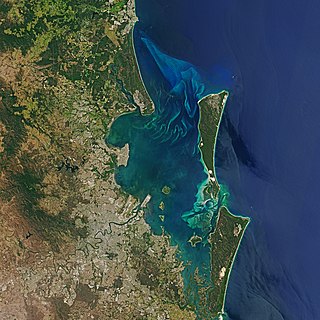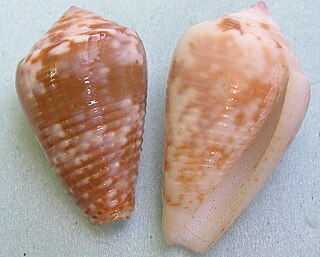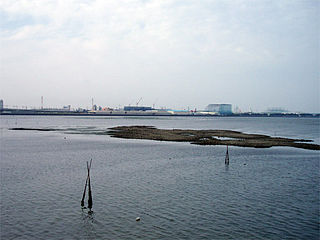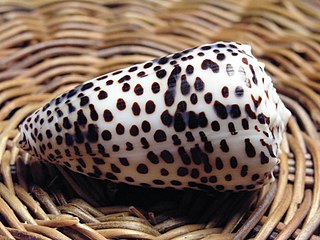
Shellfish is a colloquial and fisheries term for exoskeleton-bearing aquatic invertebrates used as food, including various species of molluscs, crustaceans, and echinoderms. Although most kinds of shellfish are harvested from saltwater environments, some are found in freshwater. In addition, a few species of land crabs are eaten, for example Cardisoma guanhumi in the Caribbean. Shellfish are among the most common food allergens.

Moreton Bay is a bay located on the eastern coast of Australia 14 kilometres (8.7 mi) from central Brisbane, Queensland. It is one of Queensland's most important coastal resources. The waters of Moreton Bay are a popular destination for recreational anglers and are used by commercial operators who provide seafood to market.

Port Phillip or Port Phillip Bay is a horsehead-shaped enclosed bay on the central coast of southern Victoria, Australia. The bay opens into the Bass Strait via a short, narrow channel known as The Rip, and is completely surrounded by localities of Victoria's two largest cities — metropolitan Greater Melbourne in the bay's main eastern portion north of the Mornington Peninsula, and the city of Greater Geelong in the much smaller western portion north of the Bellarine Peninsula. Geographically, the bay covers 1,930 km2 (750 sq mi) and the shore stretches roughly 264 km (164 mi), with the volume of water around 25 km3 (6.0 cu mi). Most of the bay is navigable, although it is extremely shallow for its size — the deepest portion is only 24 m (79 ft) and half the bay is shallower than 8 m (26 ft). Its waters and coast are home to seals, whales, dolphins, corals and many kinds of seabirds and migratory waders.

The Port River is part of a tidal estuary located north of the Adelaide city centre in the Australian state of South Australia. It has been used as a shipping channel since the beginning of European settlement of South Australia in 1836, when Colonel Light selected the site to use as a port. Before colonisation, the Port River region and the estuary area were known as Yerta Bulti by the Kaurna people, and used extensively as a source of food and plant materials to fashion artefacts used in daily life.

Glenelg is a beach-side suburb of the South Australian capital of Adelaide. Located on the shore of Holdfast Bay in Gulf St Vincent, it has become a tourist destination due to its beach and many attractions, home to several hotels and dozens of restaurants.

Ardrossan is a town in the Australian state of South Australia located on the eastern coast of the Yorke Peninsula, about 150 kilometres (93 mi) by road from the Adelaide city centre. It is notable for its deepwater shipping port and its towering coastal cliffs of red clay.

Port Noarlunga is a suburb in the City of Onkaparinga, South Australia. It is a small sea-side suburb, with a population of 2,918, about 30 kilometres to the south of the Adelaide city centre and was originally created as a sea port. This area is now popular as a holiday destination or for permanent residents wishing to commute to Adelaide or work locally. There is a jetty that connects to a 1.6 kilometres natural reef that is exposed at low tide.

The southern mud oyster, Australian flat oyster, native flat oyster, native mud oyster, or angasi oyster, is endemic to southern Australia, ranging from Western Australia to southeast New South Wales and around Tasmania. Ostrea angasi superficially resembles Ostrea edulis and both species may be referred to with the name "flat oyster". However, the two species do not occur naturally in the same geographic distribution.

Conus lividus, common name the livid cone, is a species of sophisticated predatory sea snails, marine gastropod molluscs in the family Conidae, the cone snails, cone shells or cones.

Zeacumantus is a genus of small to medium-sized sea snails or mud snails, marine gastropod mollusks in the family Batillariidae.

Nassarius granifer, common name the granulated dog whelk or granulated nassa, is a species of sea snail with an operculum, a marine gastropod mollusc in the family Nassariidae, the mud snails or dog whelks.

Aquaculture in Australia is the country's fastest-growing primary industry, accounting for 34% of the total gross value of production of seafood. 10 species of fish are farmed in Australia, and production is dominated by southern bluefin tuna, Atlantic salmon and barramundi. Mud crabs have also been cultivated in Australia for many years, sometimes leading to over-exploitation. Traditionally, this aquaculture was limited to pearls, but since the early 1970s, there has been significant research and commercial development of other forms of aquaculture, including finfish, crustaceans, and molluscs.

Conus catus, common name the cat cone, is a species of sea snail, a marine gastropod mollusk in the family Conidae, the cone snails and their allies.

Conus pertusus, common name the pertusus cone or the lovely cone, is a species of sea snail, a marine gastropod mollusk in the family Conidae, the cone snails and their allies.

Conus rattus, common name the rat cone, is a species of sea snail, a marine gastropod mollusk in the family Conidae, the cone snails and their allies.
Pyrazus is a genus of sea snails, marine gastropod mollusks in the family Batillariidae. Pyriazidae is a synonym of Batillariidae and Pyrazus is the type genus of the Pyriazidae.

Oyster reef restoration refers to the reparation and reconstruction of degraded oyster reefs. Environmental changes, modern fishing practices, over harvesting, water pollution, and other factors, have resulted in damage, disease, and ultimately, a large decline in global population and prevalence of oyster habitats. Aside from ecological importance, oyster farming is an important industry in many regions around the world. Both natural and artificial materials have been used in efforts to increase population and regenerate reefs.

Conus eburneus, common name the ivory cone, is a species of sea snail, a marine gastropod mollusk in the family Conidae, the cone snails and their allies.

The term oyster reef refers to dense aggregations of oysters that form large colonial communities. Because oyster larvae need to settle on hard substrates, new oyster reefs may form on stone or other hard marine debris. Eventually the oyster reef will propagate by spat settling on the shells of older or nonliving oysters. The dense aggregations of oysters are often referred to as an oyster reef, oyster bed, oyster bank, oyster bottom, or oyster bar interchangeably. These terms are not well defined and often regionally restricted.

Pinna bicolor, also known as razorfish, razor clam, or pen shell, is a species of large saltwater clam in the family Pinnidae. It is commonly found in shallow waters up to 50 m (160 ft) deep. It can be found embedded in firm muddy intertidal sediments, seagrass beds, and reef flats along continental and island shores.



















